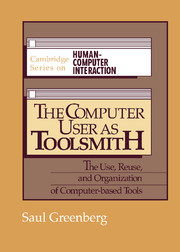Book contents
- Frontmatter
- Contents
- List of figures
- List of tables
- Foreword
- Acknowledgments and dedication
- 1 Introduction
- 2 Studying UNIX
- 3 Using commands in UNIX
- 4 Techniques for reusing activities
- 5 Recurrent systems
- 6 Reuse opportunities in UNIX csh – potential and actual
- 7 Principles, corroboration, and justification
- 8 Organizing activities through workspaces
- 9 A workspace system: description and issues
- 10 Conclusion
- Appendix A A sample trace
- Appendix B Summary statistics for each subject
- References
- Author index
- Subject index
9 - A workspace system: description and issues
Published online by Cambridge University Press: 26 May 2010
- Frontmatter
- Contents
- List of figures
- List of tables
- Foreword
- Acknowledgments and dedication
- 1 Introduction
- 2 Studying UNIX
- 3 Using commands in UNIX
- 4 Techniques for reusing activities
- 5 Recurrent systems
- 6 Reuse opportunities in UNIX csh – potential and actual
- 7 Principles, corroboration, and justification
- 8 Organizing activities through workspaces
- 9 A workspace system: description and issues
- 10 Conclusion
- Appendix A A sample trace
- Appendix B Summary statistics for each subject
- References
- Author index
- Subject index
Summary
Basically, this workbench is composed of a pair of storage cabinets, on which rests a rugged work top. The exact design of the storage cabinets depends on the kind of work you do, the kind of tools you use, the amount of space you have.
— Homeowner's How-to Treasury, Popular Science, 1976This chapter describes a design and implementation of a user support tool that embodies the reuse properties suggested in Chapters 4 through 7, and the workspace organization of Chapter 8. Called WORKBENCH, the system is a graphical window-based front end to UNIX csh. The facilities and user interface are described in the first section, along with the rationale behind its design. WORKBENCH is not an end in itself. Although recently made available to selected members of the University of Calgary's Department of Computer Science and now used by several people, it serves here as an exploration of a workspace design. It is not formally evaluated; experimental appraisal is neither credible nor necessary at this early stage. Rather, the intent is to discover how feasible it is to build a workspace, to note initial pragmatic considerations arising from its use, and to suggest research areas motivated by problems encountered or envisaged. These issues are covered in the second section.
The WORKBENCH system
WORKBENCH is a window-based facility that allows people to reuse and structure their on-line UNIX csh activities.
Information
- Type
- Chapter
- Information
- The Computer User as ToolsmithThe Use, Reuse and Organization of Computer-Based Tools, pp. 141 - 158Publisher: Cambridge University PressPrint publication year: 1993
